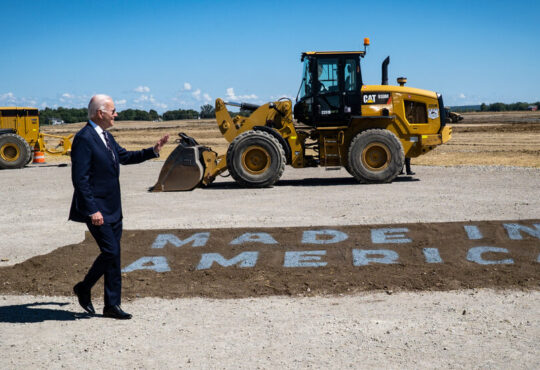
As I sat in a dark, cavernous movie theater in Berlin watching the film “Oppenheimer,” my mind was thousands of miles away.
Like many other people who turned out to see the biopic, I was captivated by Christopher Nolan’s portrayal of the Trinity test and Cillian Murphy’s performance as J. Robert Oppenheimer, the singularly ambitious, then morally conflicted father of the atomic bomb.
But as I watched images of the sprawling nuclear laboratory at Los Alamos flash across the screen, I couldn’t stop wondering: How did the U.S. government pay for the $2 billion project? Did Congress approve the money? And if so, how did lawmakers keep it a secret?
These arguably hairsplitting thoughts nagged at me thanks to my job as a congressional correspondent focused on federal spending. (I was in Berlin for a brief break — so much for that.) The assignment requires me to wade through dense legislative documents — sometimes on the order of thousands of pages — in search of projects and earmarks that lawmakers would rather taxpayers not know they are paying for.
But this was secrecy on a whole other scale.
I went home and Googled, expecting to find a lengthy Wikipedia entry or an article in a history magazine. But all I found was a snippet from a textbook published by the National Counterintelligence Center. It mentioned that Roosevelt administration officials had sought in 1944 to smuggle money for the bomb into a military spending bill, and were assisted by Congress.
I was incredulous. How could they have possibly hidden so much money? Was there really no resistance from legislators at all? I also knew that Los Alamos was built in 1943, a full year before congressional leaders secretly approved stand-alone funding for the bomb in 1944 — so how had the administration gotten the money for the project in the first place?
What followed, under the guise of what I pitched to my editor as a “fun historical memo,” was an obsessive search to find out the history of how Congress secretly funded the atomic bomb.
Over the next six months, I would visit the Library of Congress’s reading room, politely but relentlessly bug an archivist at the Sam Rayburn Library in Texas, and mine the diaries and memoirs of top congressional and military leaders, as well as the declassified history of the Manhattan Project commissioned by its director.
Those documents and interviews tell a story of presidential pressure, congressional complicity and even a touch of journalistic self-censorship. It turns out that when Congress voted to fund the bomb, there was no debate and no discussion. Only seven lawmakers in the entire Congress had any idea that they were approving $800 million — the equivalent of $13.6 billion today — to create a weapon of mass destruction that would soon kill and maim more than 200,000 people, ushering in the atomic age.
‘Do You Have the Money?’
Scrolling through the digital archives of Franklin D. Roosevelt’s library, I began to understand the lengths to which the war’s leaders had gone to keep the Manhattan Project a secret — and how much they worried about paying for it.
In a one-sentence memo in June 1942, Roosevelt wrote to Vannevar Bush, who led the early administration of the project: “Do you have the money? F.D.R.”
Paging through memos and letters between Roosevelt, his top aides and the Manhattan Project’s administrators, it was clear that by 1944, they had grown more anxious about Nazi Germany’s strides toward building an atomic weapon. To build their own, they concluded, they needed a bigger infusion of funds.
I knew from a pair of government-issued textbooks that some of those officials, including the war secretary, Henry L. Stimson, met with a handful of lawmakers — once in the House and once in the Senate — to brief them on the Manhattan Project and secure their commitment to secretly slip in hundreds of millions of dollars for the bomb.
Crucially, the books named the lawmakers who attended each meeting — just seven in total, including the speaker of the House and the Senate majority leader. I wanted to understand what the senators and congressmen invited to those secret conferences were thinking — especially because I could see that the administration was telling one story to Congress and another internally.
For instance, Stimson told lawmakers that the administration confided in them in a spirt of openness and collegiality. “We ought not to go further without taking into our confidence the leaders of both houses of Congress so that they would know the purpose of all these appropriations,” he said.
But their thinking was probably more pragmatic. Reading an account by Gen. Leslie Groves, the Army Corps of Engineers officer who directed the Manhattan Project, it was clear that officials shared the secret out of necessity, because only Congress could give them the money they needed.
“We realized from the start that this could not go on forever, for our expenditures were too vast and the project was too big to remain concealed indefinitely,” Groves wrote.
I later learned that Groves had commissioned an official, declassified history of the project, called the Manhattan District History — 36 volumes grouped into eight books.
Even now, about a third of that history remains classified. But from available records I learned that Roosevelt officials had been siphoning money for the project from funds Congress appropriated for the Army Corps of Engineers and another line item that sped the flow of munitions to Europe.
Emails to Austin
Somewhere, I thought, there must be a contemporaneous account of the meeting where lawmakers learned about the bomb. My first hope was that I could find one in letters or memos in the archives of Sam Rayburn, the legendary Texan who served as speaker at that time. That’s how I made the acquaintance of a reference intern named Dion Kauffman at the Dolph Briscoe Center for American History at the University of Texas, Austin, where Rayburn’s papers are kept. Kauffman told me that there were numerous documents pertaining to the atomic bomb, but that the earliest dated to 1945 — in other words, a full year after that the pivotal meeting.
One more folder, labeled “War Department” and cataloged with records from 1944, seemed promising. But the file’s only content, Kauffman found, was a letter “regarding the eligibility, policies and regulations for the award of the Combat and Expert Infantryman Badges.”
The only first-person account I could find from Rayburn, a 1957 interview from his home in Bonham, Texas, with the historian Forrest Pogue, gave the kind of clipped summary that I was hoping to avoid. But it did explain how lawmakers, who are famously bad at keeping their mouths shut, managed to keep this incredibly juicy secret. The answer is that they didn’t.
Rayburn said he once saw one of the congressmen who had attended the meeting talking to a reporter. The congressman, Rayburn said, “looked funny when I saw him.”
“I talked to the newspaperman later and said, ‘You are a good American, aren’t you — you love your country?’” Rayburn recalled. “He said, ‘Of course.’ I said, ‘Then don’t print anything about what he just told you.’ He didn’t, and it was all right.”
My other lucky break was that Stimson, the war secretary, was an avid diarist. At the end of most days, Stimson would record his feelings (“I felt pretty bum all day,” one entry begins), his social outings (“went for a long horseback ride”) — and crucially, his meetings.
I got access to those diaries thanks to Yale’s Beinecke Rare Book and Manuscript Library, and learned that it was Roosevelt himself who ultimately gave Stimson the go-ahead to brief a select few members of Congress, just a few days before each chamber was poised to pass the military spending bill.
But I was still looking for an account from a lawmaker in the room — ideally one that could explain how Congress approved all of that spending without realizing it. My progress was plodding because by this time, I was back in Washington covering the actual, live spending fight playing out in Congress and threatening a government shutdown.
A Lawmaker’s Memoir
As I started searching for biographical information about the lawmakers I knew attended the meeting, I learned that one of them — Senator Elmer Thomas of Oklahoma, the chairman of the Appropriations subcommittee on military spending — had published a memoir that mentioned his involvement. The book, called “Forty Years a Legislator,” didn’t appear to be in wide circulation, but I learned that there was a copy just across the street from my desk in the Capitol, at the Library of Congress.
I got a Library of Congress card and navigated my way through the building’s labyrinthine basement hallways, aware that I was going to a lot of effort to review material that might not even be useful.
But as soon as I began paging through, I realized I need not have worried. Thomas, after all, was an appropriator, a revered title reserved for lawmakers who have the power to dole out the nation’s dollars. Even now, lawmakers take this responsibility with a seriousness sometimes bordering on pedantry.
Not only had Thomas carefully recorded his own recollections of that secret meeting — he wrote that Stimson said the bomb could “do as much damage as 10,000 tons of any explosive known at that time” — but he had also included the budgetary tables of money spent on the Manhattan Project. He had even written to Stimson and the Senate Appropriations Committee secretaries who served on the panel for on-the-record versions of their stories.
One jumped out at me. Thomas seemed incredulous that, in his memory, the secret had never been shared with Congress outside of those two meetings. Could that have been true?
Appropriations aides wrote back to him: “At no time during the consideration of appropriations dealing with the prosecution of the war, either on the record or off the record, was the atomic bomb ever mentioned. During the war years, we had no knowledge in the committee as to what appropriations were available and used for this purpose.”
(Both Thomas and Rayburn, who were in separate meetings and gave separate recollections of the briefings, recalled that the military requested $800 million; the official accounts written by the military say it was $600 million — a housekeeping difference of about $3 billion in today’s money.)
His account helped me understand why there were so few recorded contemporaneous accounts of the meeting from lawmakers themselves. Thomas was invited to the secret huddle just a few hours in advance — an invitation that came from the Senate majority leader by phone, with a warning.
“He asked that I not advise any person of my whereabouts as there was to be an important conference that should not be disturbed,” Thomas recalled.
The Gadfly From Michigan
It also answered another question I had. I had found textbooks saying that a congressman from Michigan, Albert J. Engel, had gotten wind that there was something amiss going on with respect to the Manhattan Project and had privately made a fuss about it. Thomas provided the back story.
Engel, known as a gadfly, apparently made a habit of visiting military installations to look for instances of government waste and became suspicious in late 1943 when his requests to visit the military construction at Oak Ridge — where scientists were enriching uranium for the bomb — were denied.
He was assuaged years later when, with Roosevelt’s approval, the War Department invited five select congressmen, Mr. Engel included, to finally visit the facility.
The idea of a government-sanctioned field trip to essentially shut up a single congressman so amused me that I spent a lot of time trying to learn more. In doing so, I came across an apparently apocryphal tale that placed Senator Kenneth D. McKellar, the powerhouse from Tennessee and the chairman of the Appropriations Committee, in a room with Roosevelt.
In that anecdote, framed as the origin story of the Oak Ridge National Laboratory, Roosevelt asked McKellar to hide $2 billion in the budget for the bomb, to which McKellar replied, “Of course I can, but where in Tennessee are we going to hide it?”
Thomas’s memoir skewered that story. In his recollection, McKellar — who had not even been invited to the secret briefing in the Capitol — had in fact confided to fellow members of the panel that the government was building something in his state “which he feared might turn out to be a ‘white elephant.’”
“He stated that the government had secured a very large tract” and “had constructed many buildings and a vast number of residences; that the land was being enclosed with an expensive form of fencing, and that no one, not even the constructors constructing the improvements, had any idea as to what use was to be made of the project,” Thomas wrote.
Only one question remained: Where exactly in the budget had the administration hidden the money for the bomb?
Finding a bill that passed eight decades ago is harder than you might think, but after a number of creative searches, I pulled up a record of a Senate hearing examining the bill. Attached was a report breaking down the legislation.
I paged through, stopped and smiled when I saw it. There it was, the innocuous phrase that hid an $800 million secret: “expediting production.”






